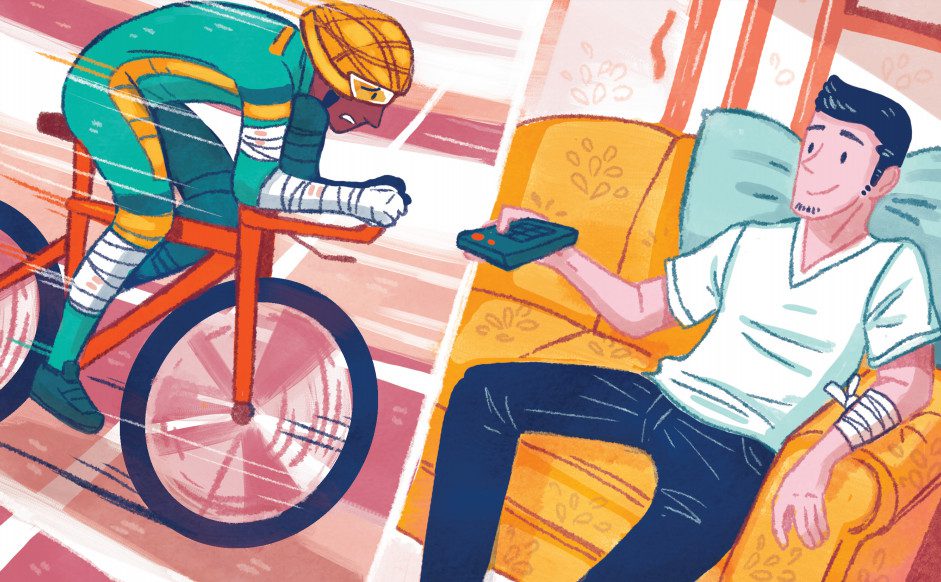Where Joes can better the pros
It’s not VO2 max or FTP that wins this shootout

by Bart Egnal

If you like to read about cycling online or in print, you’ll find pages and pages of writing that suggests we all want to be professional bike racers. Articles breathily document the incredible gear pros use. Beautiful photos capture the stunning vistas they train in. Profiles of their chefs explain what fabulous food they use. It’s all quite alluring. You could be forgiven for wanting to quit your day job and live this dream lifestyle. But not me. I’m quite content as an amateur.
Being pro – and I define pro as having bike racing as your profession, rather than your passion – comes with all sorts of restrictions and pressures that we amateurs don’t even contemplate.
Consider Aidan Caves, who won the silver medal at the 2015 Pan American track cycling championships in the scratch race. At the 2016 Pan American track cycling championships, he won the men’s omnium. He’s also been a key member of the men’s team pursuit squad. I’ve known Aidan for nearly five years and have huge respect for what he has achieved – even while he lives the pro lifestyle.
Let’s start with money. Being pro is supposed to mean earning a living through racing, which implies some kind of income. Sure, for some big-name pros, there are seven- or six-figure contracts. But for many national-level riders, they have to fundraise to compete. Even after the funding Aidan receives from Cycling Canada, he must raise thousands a year just to cover the costs of competing for the country. On the other hand, most people lining up in masters races have day jobs that fund our fun. Amateurs: 1; Pros: 0.
Next, equipment. As you know, I love equipment. From skinsuits to aero helmets to wheels – I can pick any brand or item, and mix and match it with others to get just the setup I like. Pros, such as Aidan, don’t have that luxury. They must race on the bikes, wheels and contact points supplied. They must use the skinsuit and helmet that are provided for them. Aidan mentioned that when the national team changed bike sponsors, the new fork on his Argon 18 didn’t steer the way his Look bike did. Fortunately, they custom built him one, but not all sponsors are so helpful. Amateurs: 2; Pros: 0.
Third, travel. When masters racers go off to “training camps,” we book direct flights at pleasing times of day to travel. The training is offset by the relaxation. For racers such as Aidan, global travel involves long flights that are often booked to be cost-effective rather than short. What could be a direct flight (say to Europe) is instead a multileg international odyssey. This travel makes it all the more impressive when he gets top-10s in the omnium as he did in Chile in December. Amateurs: 3; Pros: 0.
Fourth, pressure to perform, even when injured. Aidan doesn’t just compete with the world’s best on the track for World Cup points and with the hopes of making the Olympics; he must also compete with his own teammates. The pursuit team has a long list he must fight to stay on. Injuries just mean time away from results. In the time I’ve known him, he’s had concussions, broken bones, scrapes and bruises. Yet he is so focused that he gets back and returns to compete – and win – at the highest level of the sport. Contrast that with masters racing, where I took the summer off due to “fatigue.” Amateurs: 4; pros: 0.
Finally, take jerseys. When you win a big race, you get to wear a cool jersey that you actually won, such as the one connected with Aidan’s 2016 Pan Am omnium title. Whereas I don’t get to wear that kit. Amateurs: 4; pros: 1.
For all these reasons, I both love being an amateur and am committed to supporting Aidan as he pursues the Olympics. If you are inspired, as I am, by his drive and perseverance as he chases his dream of representing Canada in 2020 in Tokyo, or wish to support another athlete, you can find routes online to contribute.
And remember: it’s great to be an amateur.
